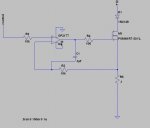Hi,
I'm interested in building my first laser and have a few question. First I'm an electrical engineer and have a decent working knowledge of circuits and general construction. My overall goal is to build a 1W 405nm laser, however I'm going to start small. I've designed a generic driver circuit that I believe will work with some minor modification up to 2A of continuous current. Attached is that schematic.
I have some questions regarding the housing of the diode however. The diode will fit inside a module, usually from aixiz. Is this the part that requires a press fit tool? Then the entire module fits inside a heatsink? Is there anywhere I can look to get examples of how the actually assembly of the diode should work and what I would need for this module, heatsink lens etc? Thank you very much for your assistance.
I'm interested in building my first laser and have a few question. First I'm an electrical engineer and have a decent working knowledge of circuits and general construction. My overall goal is to build a 1W 405nm laser, however I'm going to start small. I've designed a generic driver circuit that I believe will work with some minor modification up to 2A of continuous current. Attached is that schematic.
I have some questions regarding the housing of the diode however. The diode will fit inside a module, usually from aixiz. Is this the part that requires a press fit tool? Then the entire module fits inside a heatsink? Is there anywhere I can look to get examples of how the actually assembly of the diode should work and what I would need for this module, heatsink lens etc? Thank you very much for your assistance.







